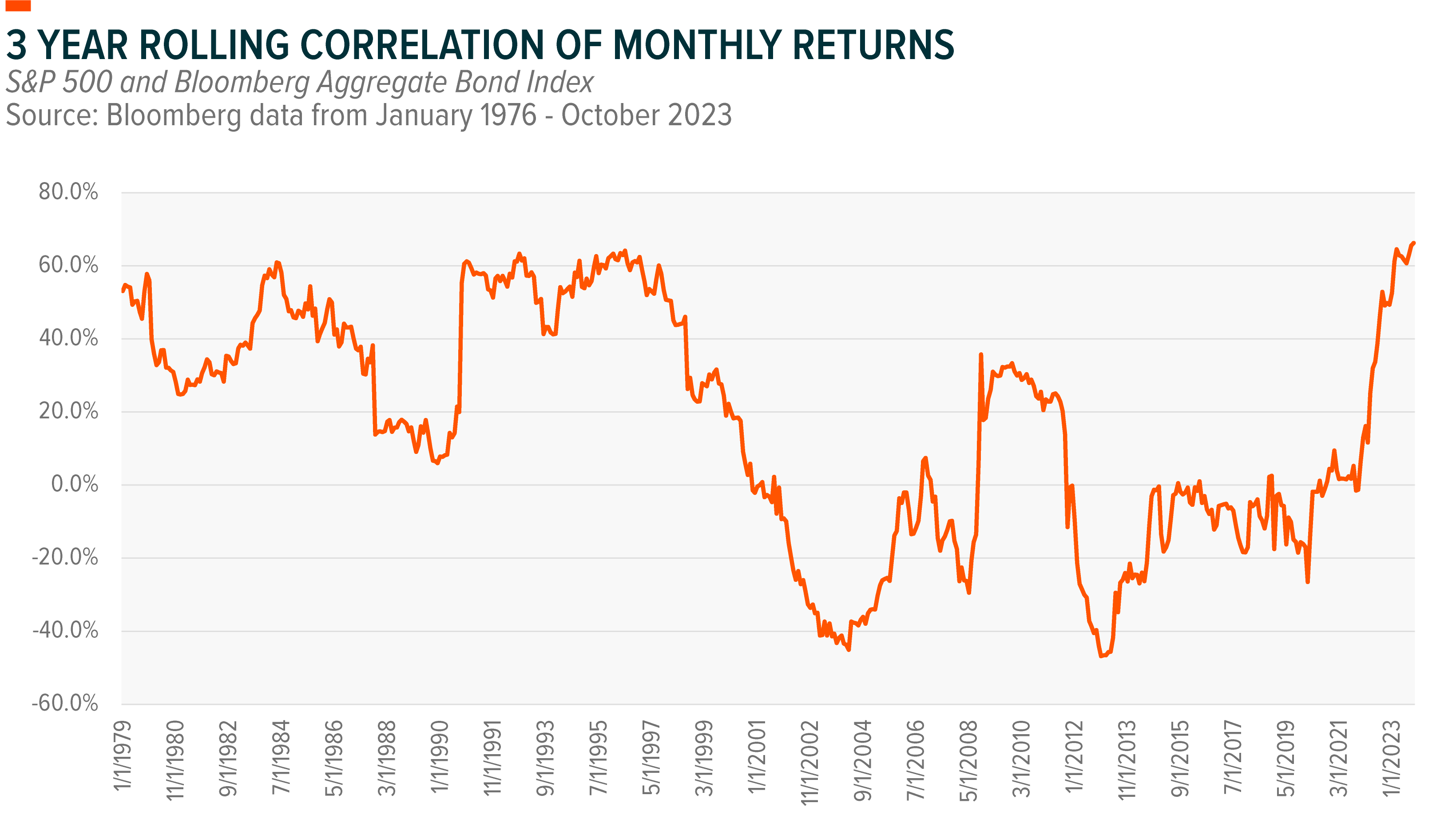2024 Outlook: Done or More to Come?
Artificial Intelligence (AI), Taylor Swift, and the Federal Reserve (Fed) had an oversized impact on either the economy or the market during 2023. Excitement surrounding AI helped the S&P 500 and Nasdaq 100 recoup a majority of their 2022 pullback.1 This exceptionally strong market rebound dominated the first half of 2023, boosting sentiment and helping markets navigate the regional banking crisis and recession expectations. Optimism surrounding AI’s potential future economic impact powered markets higher while Taylor Swift’s Eras tour boosted U.S. economic activity. Labor market tightness and the consumer’s continued willingness to spend increased the possibility of a soft landing, shifting the market’s focus back to interest rates. While “higher for longer” interest rate expectations temporarily took the shine off growthier market segments, the Fed’s actions may finally be starting to have an impact on underlying economic activity.
For investors, the task in the new year is to navigate what we expect to be a transition from robust economic growth and high interest rates to an environment of more subdued economic growth and declining yields. We believe we’re at an inflection point, with the Fed and key central banks likely already at their terminal interest rates, S&P 500 earnings returning to growth, onshoring a growing trend, and looming geopolitical risks. All these factors impact portfolio positioning for the year ahead. Overall, we believe diversification and quality core positioning remain important, but portfolios should also include select exposure to key growth areas and market segments that stand to benefit from fiscal support.
Key Takeaways
- Interest rates likely already being at their peak puts greater importance on portfolio diversification and the balance between key growthier areas and a resilient core.
- A quality and low volatility tilted core is likely to be beneficial as economic growth slows.
- The adoption of AI technology and its monetization is likely to play out over multiple years, having a lasting impact on both markets and the economy.
Importance of Portfolio Diversification Grows
The tough times for fixed income may be coming to an end
The last two years were a challenge for multi-asset portfolios. Equity and fixed income markets grappled with red-hot inflation and a rapid rise in policy rates. These factors increased the correlation between asset classes to multi-decade highs. But the 60-40 portfolio isn’t dead, it just needed yields to return to normalized levels.
We believe that markets may be at a turning point. As inflation subsides, there is opportunity for the Fed to eventually reduce policy interest rates while maintaining restrictive real interest rates. However, we view current market expectations for more than 100 basis points (bps) in cuts by the end of 2024 as potentially too extreme.2
Historically, high-quality fixed income has positive returns in the 12 months following the peak in the Fed’s rate-hiking cycle. Peak interest rates, declining interest rate volatility, and moderating economic growth are all factors supporting a favorable backdrop for fixed income that may also help restore fixed income’s diversification benefits. With US$8 trillion currently in money market funds, we could soon start seeing net flows into equity and fixed income as nominal money market yields decrease.3

Balance between risk, quality, and low volatility as economic growth slows
We believe the U.S. economy is at a transition point that has important implications for portfolio positioning. U.S. economic growth surprised to the upside in 2023 as the long and variable lag of monetary policy was longer than initially expected. But Q3 2023 economic growth was likely the peak. The tight labor market and a large cost of living adjustment supported a one-time bump in spending, but consumer balance sheet strength deteriorated over the summer and credit card and auto loan delinquencies are rising.4,5 Softer economic releases during November and December have put GDP Now on a downward trajectory for Q4, reducing inflation and interest rate risks.6 Current economic data remains resilient, walking the fine line between being inflationary and recessionary – and hopefully keeping the economy on track to achieve a soft landing.
While a soft landing is our base case scenario for the U.S. economy, downside risks to economic growth remain—after all, there’s minimal difference between a soft landing and shallow recession. Quality remains a relevant factor exposure moving into the next economic cycle. Although quality is likely to lag in the near term as reduced interest rate risk boosts risk assets, healthy balance sheets and strong cash flows are likely to take the lead as concerns about economic growth gain prominence. As a factor, quality historically outperforms in the slowdown and the contraction phases of the economic cycle.7
The low volatility factor has been out of favor with the market; however, given the drawn-out nature of the slowdown and interest rates likely being at their peak, low volatility may help provide more support as economic growth slows.8 Additionally, low volatility could provide benefits should equity market volatility rise on any potential shock factors.
We believe quality and low volatility are important factors for core exposure, but if we achieve that elusive soft landing, risk assets may have much to celebrate. Historically, slowing economic growth with rising earnings per shares (EPS) has been one of the best environments for equities since the 1950s, and in our view, this is the most likely economic environment for 2024.9 This environment is also favorable for risk assets, with lower interest rates and economic growth expectations supporting growthier and more thematic areas of the market. S&P 500 earnings growth already went through its recession, returning to positive territory in Q3 2023 with a 4.7% y/y increase.10 As the balance between goods and services demand normalizes, S&P 500 earnings are likely to improve. Typically, manufacturing is more sensitive to tightening financial conditions, which may assist with some convergence between services and manufacturing in 2024.11
Selective exposure to international
A soft landing is likely to come with a period of subdued global economic growth, particularly for developed markets. Estimates for 2024 global economic growth vary widely, from around 1.9% to 2.8% real GDP growth.12,13 European economic growth lost momentum in 2023, with stagnant Q3 GDP reducing 2023 GDP growth expectations to 0.6%. But economic activity is expected to improve into 2024 as inflation and policy tightening ease.14 The European Central Bank (ECB) is expected to lead the developed market in reducing policy interest rates, potentially starting rate cuts in Q1 2024.15
Global equities typically sell off in the three months leading up to a new round of monetary easing as markets price in expectations of slower economic growth. As a result, 2024 may be a tale of two halves, with slower global economic growth driving weaker first-half market performance and improving global economic growth leading to stronger performance in the second half.16
The 2024 international story is likely to diverge between developed and emerging markets (EM), as EM typically performs well in the 12 months following the final Fed interest rate hike. The softening U.S. dollar is already fostering a more favorable environment for EM. Additionally, while the U.S. and Europe are late cycle, China and Japan remain earlier in the cycle.17 This dynamic could create regional opportunities, especially when paired with a better balance between demand for goods and services, which could improve the Asian export cycle.18
AI Disruption Changing Commercial Paradigms
AI adoption is accelerating, and increased data use is likely to infiltrate all industries. While ChatGPT and the early forms of generative AI took the world by storm, the real opportunity is in commercial applications of AI models and the industries positioned to benefit from their adoption over the coming decades.
The computer and cell phone technology revolutions featured three distinct phases of adoption and market beneficiaries, and we expect AI to follow a similar path as it integrates into everyday technology.
- Phase 1: Computing power builds out using AI-compatible semiconductor chips.
- Phase 2: Digital infrastructure ramps up with cloud computing players.
- Phase 3: Interface and software companies capitalize by building or integrating AI models.
From a market perspective, 2023 was an excellent year for semiconductors, with the first phase of AI adoption focusing on building out compute resources. While compute power remains important, we believe the key beneficiaries of AI adoption are likely to broaden as AI monetization improves along the value chain.
Cloud Computing is a key theme that can benefit from generative AI’s growth. One emerging opportunity for cloud computing companies is AI-as-a-Service (AaaS), which is a way for them to monetize their offerings.19 The opportunity includes two key new business models, Model-as-a-Service (MaaS) and application programming interface (API), that can make it more affordable for companies to engage with AI without needing to build their own models.20
Fiscal Support Provides Multiyear Thematic Benefits
Expansionary fiscal policy supported U.S. economic resilience in 2023. Fiscal support is also encouraging U.S.-centric investment in areas that are likely to support long-term development of strategically important technology, benefitting themes such as AI and Automation. Despite increased scrutiny on budgetary and inflation concerns, reshoring critical manufacturing remains an area with bipartisan support.
Also, increased infrastructure spending and policies encouraged private sector investment into the manufacturing sector.21 While fiscal impulse provided about a 1 percentage point boost to GDP growth in 2023, given the higher base, this support is expected to fade in 2024. However, investment in U.S. infrastructure will continue over the decade and companies across its value chain can benefit.22
While the Fed may be Done, AI Adoption Has Only Just Begun
In a world that is continually evolving, innovation and change are inevitable – but we believe the rate of that change has been accelerating. We look forward to seeing how the AI story unfolds in the coming year and the decades ahead.


